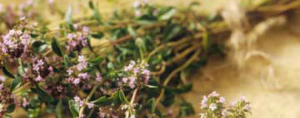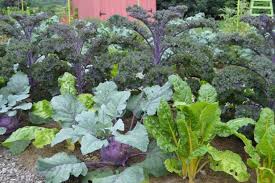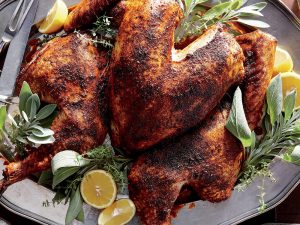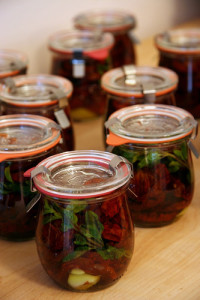Try these recipes using fresh herbs from your garden! Don’t have an herbs garden? I can teach you, more to come next week!

French Herbed Omelet
A classic French Herb Omelet. If you don’t have all the herbs, use what you have or whatever combination pleases you.
- 3 large eggs
- Sea salt and fresh ground pepper
- 2 teaspoons finely chopped Italian parsley, chives, watercress, plus more to garnish
- 1½ tablespoons unsalted butter
Whisk eggs in a bowl until the whites are completely mixed in. Add some sea salt and fresh ground pepper. Stir in the herbs.
In a small nonstick skillet (8”), melt the butter over medium heat and immediately add the eggs. Stir the eggs with a heatproof rubber spatula and slightly move the skillet around while stirring. Bring the sides over the middle so the edges don’t overcook and get crispy.
Roll the omelet from one side to the middle and while holding the pan at an angle, slide the bottom part of the omelet onto a plate and fold the rest of the omelet on top on that. You’ll have a nice little 3 fold omelet. Garnish with a few more finely chopped chives and serve.
Tomato and Goat Cheese Tart
- Tart Dough
- Makes 1-9” crust or 6 mini crusts
- 1 ½ cups flour
- pinch of salt, I use sea salt
- 10 tablespoons butter cold unsalted
- 2-4 tablespoons cold water
- Tart
- 6 ounces goat cheese
- 2 tablespoons heavy cream
- 1 tablespoon snipped fresh chives
- 1 tablespoon minced basil
- 3 large heirloom tomatoes or a large handful of cherry tomatoes
Combine the flour and salt in a food processor and pulse several times. Add butter and pulse until the mixture begins to look like little peas.
Transfer the mixture to a lightly floured surface and gather it into a ball with your hands. Gently flatten the ball into a smooth disk about 1-1/2 inches thick and wrap it in plastic. Refrigerate until firm enough to roll, at least 1 hour.
Heat the oven to 350°.
Roll the dough on a lightly floured surface into a round, about 1/8 inch thick. Roll the dough over your rolling pin and lift it over the tart pan. Unroll it loosely over the tart pan and gently press the dough into the pan without stretching it. Fold a bit of the excess dough inward to form a lip. Roll the rolling pin back and forth over the pan.
Dock the bottom of the dough by pricking with fork tines. Butter the dull side of a piece of foil and place butter side down over the dough. Fill with pie weights or dried beans.
Bake for 25 minutes until golden brown, rotate the tart pan halfway through the baking time.
Remove the crust from the oven, remove the foil and let the crust cool completely.
Preheat oven to 425°.
Mix goat cheese with just enough cream to make it spreadable. Mix in herbs and spread over the bottom of the cooled pie crust. Top with sliced tomatoes and bake until the tarts begin to bubble, and the crusts are golden brown, about 45-50 minutes. If the edges of the crust are getting too brown, cover with pieces of foil. Let cool on a rack for 15 minutes before serving.
*Can also be made into individual tart pans makes 6.
Filet of Sole with Fresh Herbs in Butter Sauce (Beurre Blanc)
Serves 4
- 3 pounds sole or other white fish
- Sea salt and fresh ground pepper
- Old Bay seasoning, optional
- 6 tablespoons Wondra flour approximately, white flour will do
- Olive oil, or sunflower, safflower or peanut
- Lemon wedges, for serving, optional
- Beurre Blanc
- 1/2 cup dry white wine
- ¼ cup white wine vinegar
- ½ tablespoon shallot (finely chopped)
- ½ pound unsalted butter (cold)
- Sea salt
- ½ tablespoon finely chopped parsley
- 1 teaspoon minced chives
- 1 teaspoon minced thyme
Heat oven to 200°.
Dry the fish with paper towels, season lightly with salt, pepper and Old Bay if using. Dredge lightly with Wondra flour.
Add enough oil to coat the bottom of the pan and brown on both sides. Remove to an oven proof plate, place in the oven while you make the sauce.
Sauce:
Cut the butter into medium (1/2-inch) cubes and return the butter cubes to the refrigerator to keep them cold, which is very important.
Heat the wine, vinegar, and shallots in a saucepan until the liquid boils, then lower the heat a bit and continue simmering until the liquid has reduced down to about 2 tablespoons.
Once the wine-vinegar mixture has reduced to 2 tablespoons, reduce the heat to low, take the cubes of butter out of the fridge and start adding the cubes, one or two at a time, to the reduction, while you whisk rapidly with a whisk.
As the butter melts and incorporates, add more butter and keep whisking. Continue until you only have 2 to 3 cubes remaining. Remove from heat while whisking in the last few cubes and whisk for a moment or two more. The finished sauce should be thick and smooth.
Season to taste with sea salt, add herbs and serve over fish with lemon wedges, if using.
Focaccia with Fresh Herbs
- 1 1/8 teaspoons active dry yeast
- 1 cup warm water, not hot
- Pinch of sugar
- 2 cups all-purpose flour
- 1 teaspoons sea salt
- 2 tablespoons fresh herbs, thyme, sage, basil, rosemary-your choice
- 2 tablespoons olive oil
Add yeast to the warm water then stir in sugar with a wooden spoon. Let stand until foamy.
Add flour, salt and herbs and stir well. Add the warm water and mix until the flour is well incorporated. Cover the bowl with plastic wrap and let rise for 2 hours or refrigerate for at least 7 hours and up to 24 hours.
Lightly coat one 9” pan with olive oil or butter then line the pan with parchment paper. Pour one tablespoon olive oil into the center of the pan. Roll the dough into a tight ball and place in the middle of the pan. Cover with plastic wrap and let rise another 2 hours. The dough should fill most of the pan when properly risen.
Preheat oven to 450°. Drizzle a little olive oil over the dough. Using your fingers press dimples all around the dough. Sprinkle with herbs and salt.
Place the pan into the oven and turn the temperature down to 425°. Bake for 30 minutes or until golden. Remove to a cooling rack.








